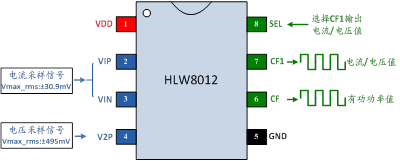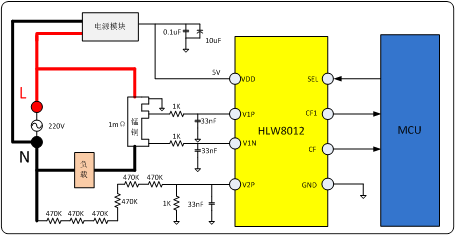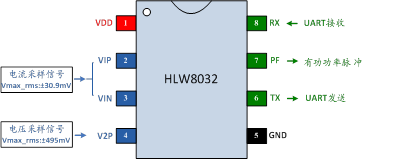OFweek smart home network news In the overall rapid development of the Internet of Things industry and market-driven, smart home manufacturers usher in a historic development opportunities. The most basic parameter of smart appliances is the “electrical†parameter, which can directly reflect the operating status of the electrical appliance. The “electrical†parameters can be measured through embedded electrical energy sensors. The core component of the electrical energy sensor is the electrical energy measurement chip. The application directions of energy metering chips in the field of Internet of Things mainly include: smart sockets, smart charging piles, smart street lights, and intelligent air conditioning. WIFI smart socket is currently the hottest application direction. It can realize intelligent control, energy saving, over-current and over-voltage overload protection, statistical power consumption information and environmental detection through remote control or outlet of the user according to electrical energy and environmental parameters. Other functions.
The well-known manufacturers of smart sockets on the market today include purple rice, green rice, guest customers, and Wukong I8. If you want to understand how the materials used in these outlets work, you can search for relevant dismantling articles on the Internet. Most of the power sensing parts commonly used in these smart sockets are a SOP8 energy metering chip HLW8012. This chip has the outstanding features of low peripheral components, small PCB area, and simple software. Therefore, many smart charging piles use the HLW8012 as power. Sensor core components. After prolonged market trials, the HLW8012 has become a very mature energy metering solution in the current Internet of Things industry.
Basic type dedicated energy metering chip HLW8012
The HLW8012 is a dedicated energy metering chip that Heli has introduced specifically for smart homes, industrial measurement and other fields. It has a built-in crystal oscillator, a 2.43V reference power supply, and a power supply monitoring circuit. The peripheral circuit is very simple. Active power, power, current, or voltage rms are output as high-frequency pulses without the need to write complex software. After the product is calibrated, the active power can reach a precision of ±0.3% within a range of 1000:1, and the effective value of current and voltage can reach an accuracy of ±0.5% within a range of 500:1.

Figure 1: Pin Diagram of HLW8012

Figure 2: Typical Application Diagram of HLW8012
Serial calibration-free energy metering chip HLW8032
Heli has displayed a new energy metering chip HLW8032 on the official website of Science and Technology. The following is a pin diagram:

Figure 3: HLW8032 Pin Diagram
Seen from the pin of the chip, HLW8032 has added UART interface on the basis of HLW8012. The HLW8032's TX is PIN6, while the HLW8012's PIN6 is active power pulse CF; the HLW8032's RX is PIN8, and the HLW8012's PIN8 is the SEL pin. The PIN6 of the HLW8012 is a must-have pin. For many ARM chips, the pin connected to the CF is easily switched to the RX end of the UART interface of the MCU. This design provides convenient hardware compatibility with the HLW8012. According to official data, when the HLW8032 is applied to a product and the maximum measurement error of the finished product is 2%, the calibration process can be saved during the production process. However, Heli has retained the PF pin for the whole machine calibration.
It appears that the HLW8032's advancement should be to meet the requirements of different designs for the interface; or in part to improve the production efficiency and save the calibration process, and is willing to reduce the error index to a certain range of applications. The HLW8032 can be regarded as a suitable transitional energy metering chip designed based on the wide market application of the HLW8012, in order to meet some application occasions and consider compatibility with the HLW8012. The reason why it is transitional is because the electrical parameters of the electrical energy sensor in future Internet of Things applications will not be limited to the existing parameters.
All-round energy metering chip HLW811X
Through the side of understanding, the author found that there are more advanced applications than the HW803803 advanced chip, tentative model is HLW811X, the initial characteristics of this chip information:
(1) Integrated crystal oscillator, more flexible communication interface
(2) Provide 1 channel active power calculation, 1 channel voltage and 1 channel RMS calculation (higher accuracy)
(3) Integrate more safe electricity detection, more electrical parameter measurement and output via IO
(4) Less error-free calibration function
(5) Operating voltage: 3.3V
According to official sources, the final product will exceed the above expectations. If this is true, the application of this chip in the field of Internet of Things will be very extensive. I look forward to it.
Market prospects
With the rapid development of the Internet of Things and big data, the demand for data in intelligent life is bound to increase. Smart home appliances must integrate all kinds of sensors. The electric energy sensor, as the most basic sensor, will also become a standard product, and it will tend to be smaller in size, simpler in interface, more versatile, and more intelligent. As a key component of the power sensor, the energy metering chip will be more compact, more powerful, more accurate, more integrated, and capable of simple self-learning.
Shaft inserting is one of the process for rotor production for motors and generators. Some of customers require the Rotor Core, but some of them also require the rotor with shaft. We are able to do shaft inserting for both samll and big rotors. And we can also do lathe work for rotors after inserting the shafts.
Rotor Shaft Inserting,Rotor Shaft,Rotor With Shaft,Motor Rotor Shaft
Henan Yongrong Power Technology Co., Ltd , https://www.hnyongrongglobal.com